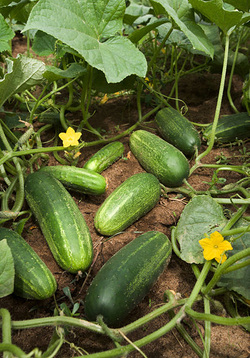
In my last post I talked of a garden that I loved dearly.. even just watching it grow in the summer was a pleasure to me. Unfortunately the old gentleman who tended it has passed, and the garden is no more.. But the spirit of it will live on with all of those who he inspired to grow a garden themselves. Details of how to grow pretty much everything can be found all over the internet, but cucumbers and lettuces struck me as wonderful beginner veggies, so I've outlined some easy to follow guides.
Cucumbers
1. Cucumbers come in all shapes, sizes, textures, and colors. Choose one that suits your needs (I like slicing cucumbers the best, personally). They're best grown from seeds, and should be planted in rich, mulchy, composty soil about 1/2-1” deep, in clusters of 3-4 seeds. Space clusters 8-12” apart for best results (and least crowding).
Also, keep in mind that cucumbers and cool weather do not mix. Cucumber seeds won't germinate until the soil temperature hits around 70 degrees, and plants will just sit there, not doing much of anything, unless the weather is consistently warm. Don't bother sowing cucumber seeds until three to four weeks after your last frost date, because chances are they will become bird seed.
2. Cucumbers, like ducklings, LOVE water. They grow super fast and will need to be kept consistently moist, and once they start fruiting they will require even more. Regular watering is essential. Daily. No slacking.
3. They'll start producing fruit withing 45-65 days of planting. Like I said, they grow super fast. Keep them watered, and pick fruit once desired size is reached (before they go soft, though).
~Note~
Be careful of the spiny vines when harvesting. Using scissors is a good idea :)
Cucumbers
1. Cucumbers come in all shapes, sizes, textures, and colors. Choose one that suits your needs (I like slicing cucumbers the best, personally). They're best grown from seeds, and should be planted in rich, mulchy, composty soil about 1/2-1” deep, in clusters of 3-4 seeds. Space clusters 8-12” apart for best results (and least crowding).
Also, keep in mind that cucumbers and cool weather do not mix. Cucumber seeds won't germinate until the soil temperature hits around 70 degrees, and plants will just sit there, not doing much of anything, unless the weather is consistently warm. Don't bother sowing cucumber seeds until three to four weeks after your last frost date, because chances are they will become bird seed.
2. Cucumbers, like ducklings, LOVE water. They grow super fast and will need to be kept consistently moist, and once they start fruiting they will require even more. Regular watering is essential. Daily. No slacking.
3. They'll start producing fruit withing 45-65 days of planting. Like I said, they grow super fast. Keep them watered, and pick fruit once desired size is reached (before they go soft, though).
~Note~
Be careful of the spiny vines when harvesting. Using scissors is a good idea :)
Lettuces
It's amazing how few people realize the joys of lettuces. They're easy to grow, don't require a lot of space, and are so much better tasting than what's available at Safeway. They're a cool-weather crop, so sow seeds as soon as the ground can be worked in the spring or after the hottest days of the summer.
1. Plant seeds outdoors in beds or rows 1/4 to 1/2 inch deep, 6 to 8 inches for loose-headed types, and 12 to 16 inches for firm-headed types. Water every other day, but don't soak. If the soil gets permanently soggy the roots can develop root rot.
~Sow in semi-shaded areas in late spring to extend the harvest into the summer.
~~Plant three rotations of plants, at 10-14 day intervals, for a longer harvest season.
2. Apply a layer of mulch (1-3”) in early summer to keep the soil cool.
3. Insects and diseases are rare in home lettuce plantings, but spritzing lightly with a vinegar-water solution is a natural and harmless way to keep pests off of plants.
4. Since all leaf lettuces grow at different paces, harvest times vary, but the leaves will look full and lovely. For the bestest lettuces, harvest in the morning when they're crispest.
It's amazing how few people realize the joys of lettuces. They're easy to grow, don't require a lot of space, and are so much better tasting than what's available at Safeway. They're a cool-weather crop, so sow seeds as soon as the ground can be worked in the spring or after the hottest days of the summer.
1. Plant seeds outdoors in beds or rows 1/4 to 1/2 inch deep, 6 to 8 inches for loose-headed types, and 12 to 16 inches for firm-headed types. Water every other day, but don't soak. If the soil gets permanently soggy the roots can develop root rot.
~Sow in semi-shaded areas in late spring to extend the harvest into the summer.
~~Plant three rotations of plants, at 10-14 day intervals, for a longer harvest season.
2. Apply a layer of mulch (1-3”) in early summer to keep the soil cool.
3. Insects and diseases are rare in home lettuce plantings, but spritzing lightly with a vinegar-water solution is a natural and harmless way to keep pests off of plants.
4. Since all leaf lettuces grow at different paces, harvest times vary, but the leaves will look full and lovely. For the bestest lettuces, harvest in the morning when they're crispest.
 RSS Feed
RSS Feed